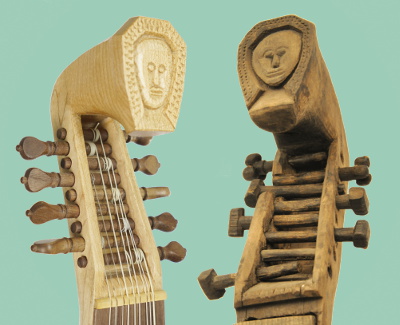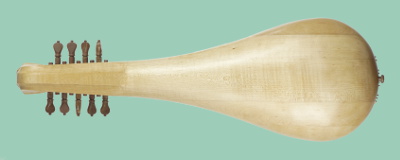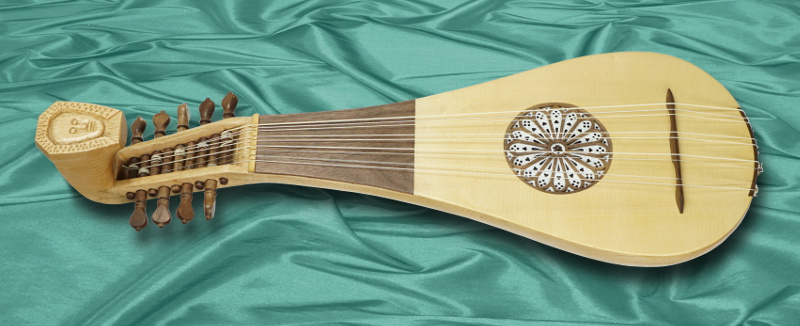 |
Elblag Koboz |
|
Koboz
This is a reconstruction, commissioned by Ian Pittaway, of an instrument recently discovered during an archaeological dig in Elblag, in Poland. It is one of several instruments found in a latrine, where conditions preserved the wood remarkably well. 
Heads - reproduction and original

Side View

Bottom View

Rose
It is usually called the "Elblag Gittern", but after much research and experimentation, and lengthy correspondence with the staff of Elbag Museum, we are now convinced that it is a medieval version of the Koboz (or cobza), an instrument which is still commonly played in eastern Europe. The full story of our research and reconstruction is detailed in a 2-part article, with musical examples, on Ian's website, "Early Music Muse". It also has extensive historical information on the koboz : The original instrument is quite crudely carved. I have tried to keep the rustic feel, while smartening it up a little. The original tuning is unknown. There is some evidence that the stringing was changed at some point during its life. Ian has experimented with various options, based on modern Koboz tuning and historical gittern tunings, and arrived at a very workable schedule which makes the instrument sing. It is double-strung on the lower three courses, with a triple top course : g g' d d' g' g' c'' c'' c' YouTube has many fine examples of the modern koboz being played. It is usually played with a plectrum. Different players prefer modern guitar picks, goose quills, or a "risha", similar to that used on the Arabic Ud. Ian has made some progress in researching music from medieval Poland, to provide an appropriate repertoire for the koboz. A couple of sound clips can be heard below. The tuning can, of course, be modified to your own specification. With slight modifications to the shape of the neck, and the addition of frets, it can be set up as a gittern, if you don't fancy East European medieval music. Sound Clips“Breve regnum erigitur” “Angelus ad virginem missus” (excerpt) Prices
To order or enquire, pleasecontact me Cases - Excellent cases can be ordered from specialist manufacturers such as Kingham MTM, but they're pricy. I can supply an attractive, custom-built plywood case, black with chrome fittings, for £220 when ordered with an instrument. Delivery - the price depends on where you live. Please enquire. I hate it when websites say "Phone for a quote", so to give you some idea - getting a baroque guitar in its case to America, including insurance, is currently about £170. Getting one to Kent is about half that. Waiting time, from placing an order to clutching your new baby, is currently about 16 months. It's very approximate, because the schedule often contains items that are somewhat experimental, and they may take more or less time to complete than anticipated. Usually more. Deposit- I usually ask for £150 (non-returnable unless I'm dead, insane, incapacitated or incarcerated) to secure an order and cover materials. Once that's paid, your order is entered into my Magic Book. Nothing happens for several months, then you receive an email to tell you I've started construction. A few weeks later, a big parcel arrives, and you squeal with delight.
Anote on HUMIDITY - delicate wooden instruments are remarkably resilient, but
they can have major problems with both high and low atmospheric humidity levels. I keep my workshop at the
recommended humidity level, between 45% and 50%, and I strongly recommend that instruments are kept as close
to that range as possible. Electronic humidity meters are available cheaply on the Internet. They're small enough
to keep in your instrument's case. |
 More Instruments |
 Diabolus Homepage |
 Email for Diabolus |
